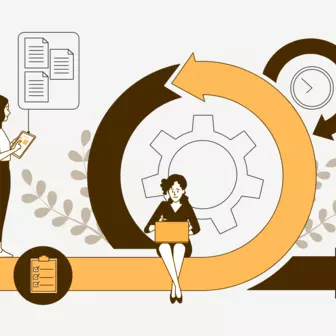The web app development industry is one that has gone through significant transformations over time. The modus operandi for web app development has shifted from the break-and-remake approach to a more dynamic and progressive one. This vibrant and fluid approach is what is known as the Continuous Delivery approach to web app development.
At a deeper level, tech companies use this approach to ensure that their web apps or software goes live while working to improve on it. This approach reduces downtime and saves costs for the company.

Take Facebook, for instance. Their web app keeps running while they work on improvements and upgrades. When upgrades are ready, users do not need to experience glitches while still using older versions of the web app.
The same system works for many web apps that are being deployed today.
There are times when you have to uninstall an older version of the web app to install the latest version. This process creates downtime for users, and some data could be lost in the process.
Though there is software that still requires that you take out the old to bring in the new, the majority of tech companies are fast adopting the Continuous Delivery model.
The role of changing culture
At the core of this innovation is culture change. The way people interact with their devices and web apps are changing with time. Any tech company that wants to remain relevant and innovative must align with the demands of changing culture.
This culture change isn’t only about users; investors are becoming more proactive in their dealings with software manufacturing companies.
Jez Humble and David Farley sited a practical example in their book, Continuous Delivery: Reliable Software Releases through Build, Test, and Deployment Automation (Addison-Wesley Signature Series (Fowler)) 1st Edition:
There are times when investors will demand a demonstration of software that’s still undergoing development. They do this to know if they can continue with the project or not. Of course, no one wants to continue investing in a project that doesn’t look promising.
You will be shooting yourself in the foot if you don’t make it happen because the prototype isn’t ready. You should be able to have working software that would show no case a couple of its features as a demo to your investors.
This wasn’t the case some 20, 30 years ago. Demonstrations are scheduled after the software is ready to be launched.
The changing lifestyle of tech users and investors has contributed immensely to the success of the Continuous Delivery approach.
How does it affect web app development and deployment?
The changing culture has put IT companies in a position to design their web apps to go with the flow continually. Here are a few ways Continuous Delivery plays a vital role in helping tech companies adapt to changing culture.
- Tech companies have to build systems that support the iterative release of web apps. Involves not using tight or intricate codings that could make updates difficult. Web apps should be created such that faults can be detected quickly and in real-time.
- There has to be a constant test-driven development practice to allow the app codings to stay in deployable state at all times. This test should be done in a robust and comprehensive test suite that allows for the kind of tweaks that would be expected all through the running cycle of the web app. Tracking and monitoring systems should be built in by design to allow for easy fault detection and improvement with time.
- Complex or massive iterations shouldn’t be a part of the process. The iterations should be so small that web app features can be modified daily if need be. Use feature flags if you intend to spend more time in developing more features for your web app or software.
- Every coding should be done in production-like staging environments. That way, the new version of the web app wouldn’t malfunction when it is released to be used. Also, the transition from older versions to more modern versions becomes more seamless.
- User-friendliness is essential if your web app must adapt to cultural changes in the Continuous Delivery approach. The codes should be written such that anyone can quickly deploy any version of the web app as the need arises. Your tech engineers might not always be there to do the technical stuff. For instance, a professional from a writing service review website such as Best Writers Online with basic coding knowledge should be able to walk through the codes in a breeze.
- You take responsibility for running the software you build. However, you can work with teams to achieve higher goals with time. That way, your web app or software stays relevant to the changing needs of users.
Deployment pipeline for the Continuous Delivery approach
Every tech approach has a process that makes it possible to function effectively. For the Continuous Delivery approach, the process is the deployment pipeline.
At a basic level, this is how tech companies take the feature in the mind of users and input it into the web app as updates.
Three components make up the deployment pipeline - visibility, feedback, and continuous deployment.
- Visibility: The process of building or upgrading a web app or software involves teams working together openly and transparently. Information about the building, testing, deployment, and release of the web app or software should be available to all involved. This coordination is necessary as individual inputs will bring to fore different perspectives that will ensure the success of the Continuous Delivery approach.
- Feedback: This is the part where changing culture plays a significant role. Especially when it’s an update that’s in the pipeline or a glitch that was observed in the already running software. Feedback from users will provide the needed insight to fix bugs and remove bottlenecks that inhibit the smooth usage of the software.
- Continuous Deployment: As a result of changing culture and consumer needs, constant and constant attention is channelled to making already running web apps give users better engagement. This is the heart and soul of the Continuous Delivery approach. Of course, it should be an automated process to ensure a continuous workflow.
Benefits of the Continuous Delivery Approach
Apart from adapting to changing culture, there are other benefits that tech companies enjoy from implementing the Continuous Delivery approach in web application development.
- It’s easier and quicker for tech companies to deliver the business values of new software releases. That way, they can stay ahead of the competition.
- The number of iterations needed to build perfect software is reduced drastically. This is a result of the continuous deployment of feedback obtained from users.
- Tech companies enjoy improved productivity and efficiency. They can save time through automation.
- Release of reliable products. The biggest hit a tech company can suffer is to release software that isn’t reliable. You don’t have a second chance to make an excellent first impression. This is while you need to be in tune with changes in the culture so you can teak what’s needed quickly.
- Full customer satisfaction is guaranteed. When your web application is continuously relevant to customers’ needs, you enjoy customer loyalty more.
In Conclusion
For the Continuous Delivery approach to continually deliver on its promise, it must align with changing culture. People’s IT needs are changing per time, and tech companies should go with the flow to remain relevant. There are billions of apps already released across the app stores and tons of software coming out every day. However, the ones that enjoy the highest usage volumes are in touch with changes in culture.
Subscribe
Related Blogs
Exploring Drupal's Single Directory Components: A Game-Changer for Developers

Web development thrives on efficiency and organisation, and Drupal, our favourite CMS, is here to amp that up with its…
7 Quick Steps to Create API Documentation Using Postman

If you work with API , you are likely already familiar with Postman, the beloved REST Client trusted by countless…
What is Product Engineering Life Cycle?

Imagine constructing a house without a blueprint or a set of plans. It will be challenging to estimate the cost and labor…




